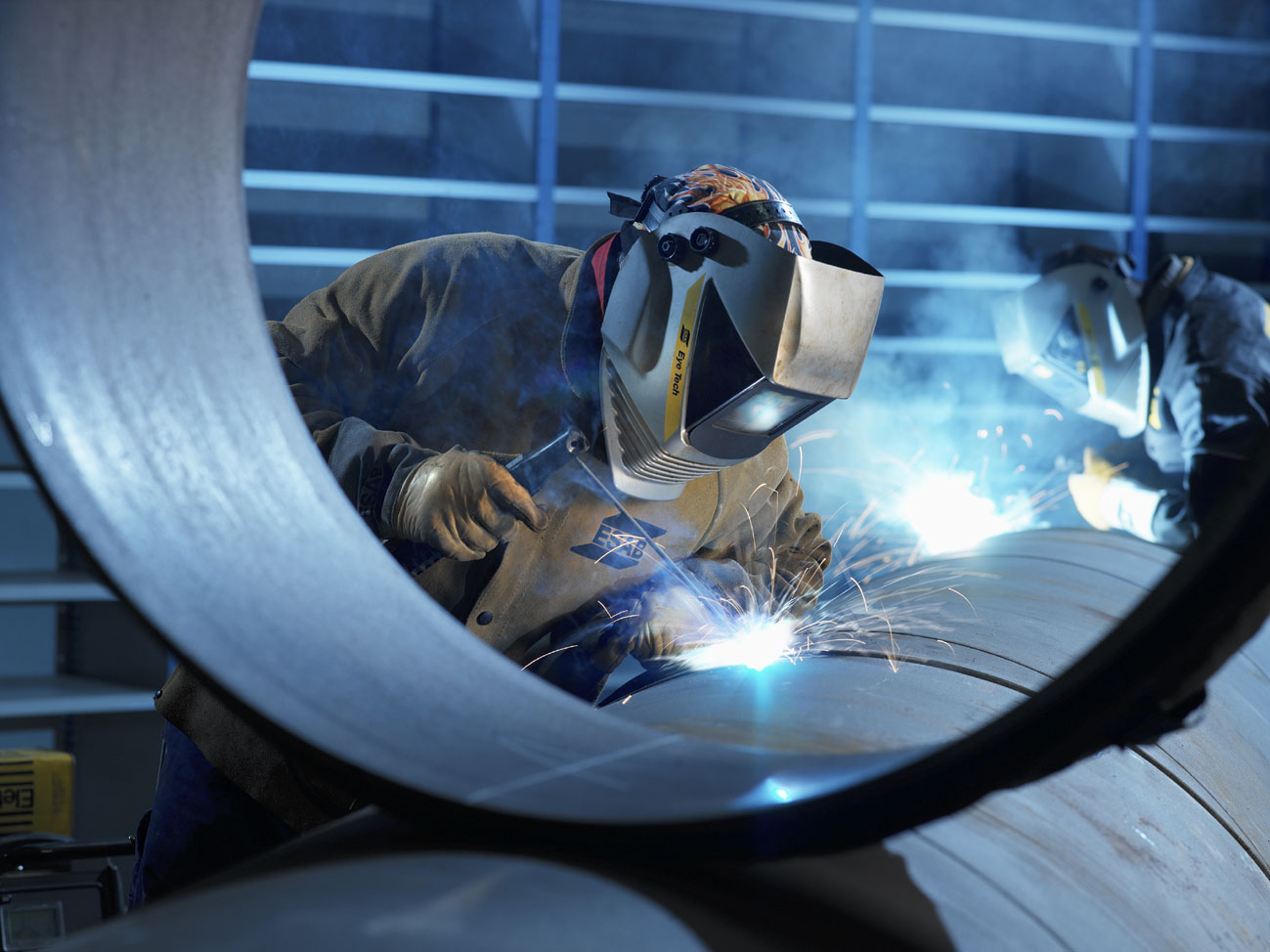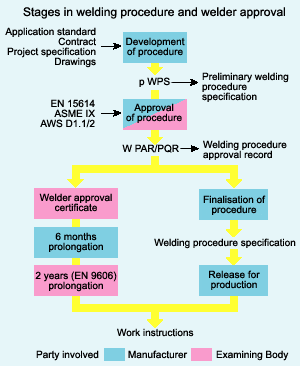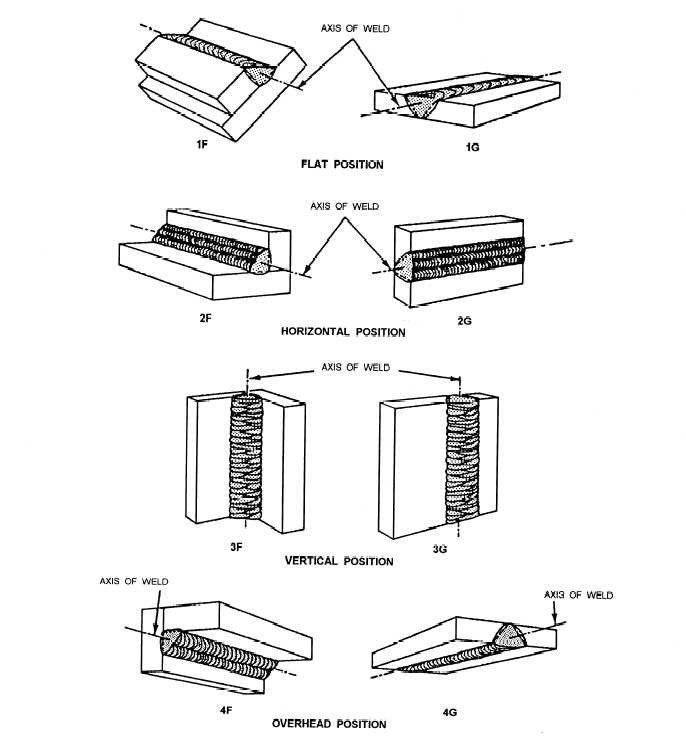The Welding History
The Bible mentions Tubal Cain, “forged all types of tools from bronze and iron.” He may have been one of the first to join metals with the forging process. His flame was an open hearth into which he placed the metals to be heated to the forging temperature.
Welding
Welding can trace its historic development back to ancient times. The earliest examples come from the Bronze Age. Small gold circular boxes were made by pressure welding lap joints together. It is estimated that these boxes were made more than 2000 years ago. During the Iron Age the Egyptians and people in the eastern Mediterranean area learned to weld pieces of iron together.
Many tools were found which were made approximately 1000 B.C. During the Middle Ages, the art of blacksmithing was developed and many items of iron were produced which were welded by hammering. It was not until the 19th century that welding, as we know it today was invented.
1800
Edmund Davy of England is credited with the discovery of acetylene in 1836. The production of an arc between two carbon electrodes using a battery is credited to Sir Humphry Davy in 1800. In the mid-nineteenth century, the electric generator was invented and arc lighting became popular. During the late 1800s, gas welding and cutting was developed. Arc welding with the carbon arc and metal arc was developed and resistance welding became a practical joining process. In 1881, French scientist Auguste De Meritens succeeded in fusing lead plates by using the heat generated from an arc. Later, Russian scientist Nikolai N. Benardos and his compatriot Stanislaus Olszewski developed an electrode holder for which they secured US and British patents.
1890
In 1890, C.L. Coffin of Detroit was awarded the first U.S. patent for an arc welding process using a metal electrode. This was the first record of the metal melted from the electrode carried across the arc to deposit filler metal in the joint to make a weld. About the same time, N.G. Slavianoff, a Russian, presented the same idea of transferring metal across an arc, but to cast metal in a mold. During the 1890′s, one of the most popular welding methods was carbon arc welding. Around the same time, American C.L. Coffin secured a US patent for metal electrode arc welding. N.G. Slavianoff of Russia used the same principle for casting metals in molds.
1900
Approximately 1900, Strohmenger introduced a coated metal electrode in Great Britain. There was a thin coating of clay or lime, but it provided a more stable arc. Oscar Kjellberg of Sweden invented a covered or coated electrode during the period of 1907 to 1914. Stick electrodes were produced by dipping short lengths of bare iron wire in thick mixtures of carbonates and silicates, and allowing the coating to dry. Coated metal electrode was first introduced in 1900 by Strohmenger. A coating of lime helped the arc to be much more stable. A number of other welding processes were developed during this period. Some of them included seam welding, spot welding, flash butt welding, and projection welding. Stick electrodes became a popular welding tool around this time as well.
Meanwhile, resistance welding processes were developed, including spot welding, seam welding, projection welding and flash butt welding. Elihu Thompson originated resistance welding. His patents were dated 1885-1900. In 1903, a German named Goldschmidt invented thermite welding that was first used to weld railroad rails. Gas welding and cutting were perfected during this period as well.
1919
After the end of World War I, the American Welding Society was established by Comfort Avery Adams. The aim of the society was the advancement of welding processes. CJ Holstag also invented the alternating current in 1919. However, alternating current was first commercially utilized by the welding industry only in the 1930′s. Immediately after the war in 1919, twenty members of the Wartime Welding Committee of the Emergency Fleet Corporation under the leadership of Comfort Avery Adams, founded the American Welding Society as a nonprofit organization dedicated to the advancement of welding and allied processes. Alternating current was invented in 1919 by C.J. Holslag; however it did not become popular until the 1930s when the heavy-coated electrode found widespread use.
1920
In 1920, automatic welding was introduced. It utilized bare electrode wire operated on direct current and utilized arc voltage as the basis of regulating the feed rate. Automatic welding was invented by P.O. Nobel of the General Electric Company. It was used to build up worn motor shafts and worn crane wheels. It was also used by the automobile industry to produce rear axle housings. Automatic welding was first introduced in 1920. Invented by P.O. Nobel, automatic welding integrated the use of arc voltage and bare electrode wires. It was used for repairing and molding metals. Several types of electrodes were also developed during this decade.
During the 1920s, various types of welding electrodes were developed. There was considerable controversy during the 1920s about the advantage of the heavy-coated rods versus light-coated rods. The heavy-coated electrodes, which were made by extruding, were developed by Langstroth and Wunder of the A.O. Smith Company and were used by that company in 1927. In 1929, Lincoln Electric Company produced extruded electrode rods that were sold to the public. By 1930, covered electrodes were widely used. Welding codes appeared which required higher-quality weld metal, which increased the use of covered electrodes.
1930
The New York Navy Yard developed stud welding. Stud welding was increasingly used for the construction industry and also for shipbuilding. It was during this time that the National Tube Company developed a welding process called smothered arc welding. In the sector of shipbuilding, the stud welding process was replaced by the more advanced submerged arc welding. Stud welding was developed in 1930 at the New York Navy Yard, specifically for attaching wood decking over a metal surface. Stud welding became popular in the shipbuilding and construction industries.
The automatic process that became popular was the submerged arc welding process. This “under powder” or smothered arc welding process was developed by the National Tube Company for a pipe mill at McKeesport, Pennsylvania. It was designed to make the longitudinal seams in the pipe. The process was patented by Robinoff in 1930 and was later sold to Linde Air Products Company, where it was renamed Unionmelt® welding. Submerged arc welding was used during the defense buildup in 1938 in shipyards and in ordnance factories. It is one of the most productive welding processes and remains popular today.
1940
A new type of welding for seamlessly welding aluminum and magnesium was developed in 1941 by Meredith. This patented process came to be known as Heliarc welding. The gas shielded metal arc welding or GTAW was another significant milestone in the history of welding which was developed in Battelle Memorial Institute in 1948. Gas tungsten arc welding (GTAW) had its beginnings from an idea by C.L. Coffin to weld in a nonoxidizing gas atmosphere, which he patented in 1890. The concept was further refined in the late 1920s by H.M.Hobart, who used helium for shielding, and P.K. Devers, who used argon. This process was ideal for welding magnesium and also for welding stainless and aluminum. It was perfected in 1941, patented by Meredith, and named Heliarc® welding. It was later licensed to Linde Air Products, where the water-cooled torch was developed. The gas tungsten arc welding process has become one of the most important.
The gas shielded metal arc welding (GMAW) process was successfully developed at Battelle Memorial Institute in 1948 under the sponsorship of the Air Reduction Company. This development utilized the gas shielded arc similar to the gas tungsten arc, but replaced the tungsten electrode with a continuously fed electrode wire. One of the basic changes that made the process more usable was the small-diameter electrode wires and the constant-voltage poser source. This principle had been patented earlier by H.E. Kennedy. The initial introduction of GMAW was for welding nonferrous metals. The high deposition rate led users to try the process on steel. The cost of inert gas was relatively high and the cost savings were not immediately available.
1950
The CO2 welding process popularized by Lyubavskii and Novoshilov in 1953 became a welding process of choice for welding steels, as it was comparatively economical. Soon, electrode wires of smaller diameter were launched. This made welding of thin materials more convenient. In 1953, Lyubavskii and Novoshilov announced the use of welding with consumable electrodes in an atmosphere of CO2 gas. The CO2 welding process immediately gained favor since it utilized equipment developed for inert gas metal arc welding, but could now be used for economically welding steels. The CO2 arc is a hot arc and the larger electrode wires required fairly high currents. The process became widely used with the introduction of smaller-diameter electrode wires and refined power supplies. This development was the short-circuit arc variation which was known as Micro-wire®, short-arc, and dip transfer welding, all of which appeared late in 1958 and early in 1959. This variation allowed all-position welding on thin materials and soon became the most popular of the gas metal arc welding process variations.
1960
Another variation was the use of inert gas with small amounts of oxygen that provided the spray-type arc transfer. It became popular in the early 1960s. A recent variation is the use of pulsed current. The current is switched from a high to a low value at a rate of once or twice the line frequency.
The electroslag welding process was announced by the Soviets at the Brussels World Fair in Belgium in 1958. It had been used in the Soviet Union since 1951, but was based on work done in the United States by R.K. Hopkins, who was granted patents in 1940. The Hopkins process was never used to a very great degree for joining. The process was perfected and equipment was developed at the Paton Institute Laboratory in Kiev, Ukraine, and also at the Welding Research Laboratory in Bratislava, Czechoslovakia. The first production use in the U.S. was at the Electromotive Division of General Motors Corporation in Chicago, where it was called the Electro-molding process. It was announced in December 1959 for the fabrication of welded diesel engine blocks. The process and its variation, using a consumable guide tube, is used for welding thicker materials.
The Arcos Corporation introduced another vertical welding method, called Electrogas, in 1961. It utilized equipment developed for electroslag welding, but employed a flux-cored electrode wire and an externally supplied gas shield. It is an open arc process since a slag bath is not involved. A newer development uses self-shielding electrode wires and a variation uses solid wire but with gas shielding. These methods allow the welding of thinner materials than can be welded with the electroslag process.
Gage invented plasma arc welding in 1957. This process uses a constricted arc or an arc through an orifice, which creates an arc plasma that has a higher temperature than the tungsten arc. It is also used for metal spraying and for cutting. The electron beam welding process, which uses a focused beam of electrons as a heat source in a vacuum chamber, was developed in France. J.A. Stohr of the French Atomic Energy Commission mad the first public disclosure of the process on November 23, 1957. In the United States, the automotive and aircraft engine industries are the major users of electron beam welding.
Most Recent
Friction welding, which uses rotational speed and upset pressure to provide friction heat, was developed in the Soviet Union. It is a specialized process and has applications only where a sufficient volume of similar parts is to be welded because of the initial expense for equipment and tooling. This process is called inertia welding.
Laser welding is one of the newest processes. The laser was originally developed at the Bell Telephone Laboratories as a communications device. Because of the tremendous concentration of energy in a small space, it proved to be a powerful heat source. It has been used for cutting metals and nonmetals. Continuous pulse equipment is available. The laser is finding welding applications in automotive metalworking operations.
You might also like
| Brazing What is Brazing ? Brazing is a metal-joining... | Welding Pictures Welding is a fabrication or sculptural process that... | Welding Procedure What Are Welding Procedures ? A Welding... | Welding Positions What`s Kind of Welding Positions ? Welding... |



 Alloy Suppliers
Alloy Suppliers
 Aluminum
Aluminum
 Aluminum Extrusions
Aluminum Extrusions
 Copper-Brass-Bronze
Copper-Brass-Bronze
 Nickel
Nickel
 Magnets
Magnets
 Stainless Steel
Stainless Steel
 Stainless Steel Tubing
Stainless Steel Tubing
 Steel Service Centers
Steel Service Centers
 Titanium
Titanium
 Tungsten
Tungsten
 Wire Rope
Wire Rope